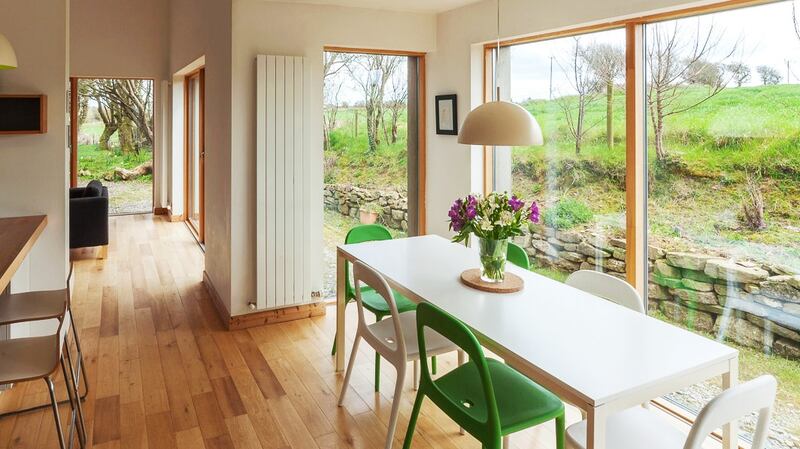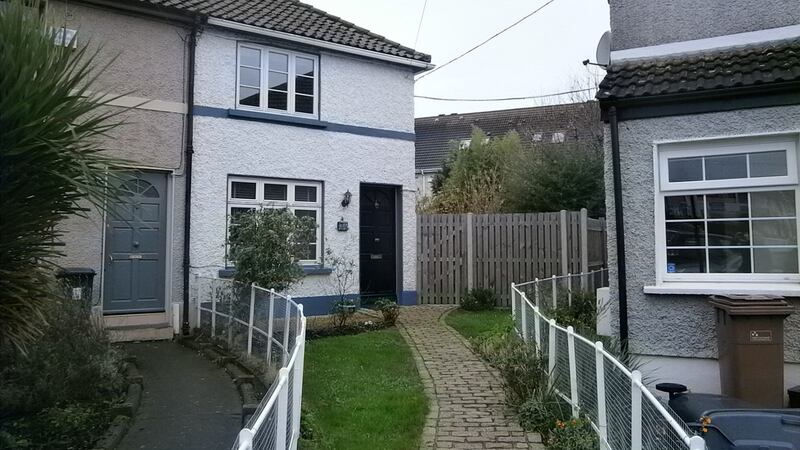We all remember the satisfaction of building that perfect Lego house when we were kids, but imagine having the skill and expertise to design and create your own home as an adult.
This is something most of us can only dream of, but for those with the right qualifications and know-how, building a unique home is very much a reality.
Paul Conway jokingly says his wife, Bella, was his client when he drew up the plans for their family home outside Ennistymon in Co Clare. But the experienced architect also knew what he wanted when he designed the four-bedroom, split-level house in 2012.

“I had always wanted to build my own house, but the most important thing for me was getting the site right,” he says. “I would always encourage people to think about the location first and the house second. Because of this, I spent a good few years looking for the right place and as soon as I saw it, I knew it was perfect.
“It was heavily overgrown with what turned out to be mostly apple tree. So we now have a lovely orchard and there is also a bit of a view of the sea while we are also surrounded by countryside.”
Once the site was bought and plans approved, Conway put his mind to designing a home for his family (he also has two grown-up children). Despite having a free rein to do as he pleased, his clients’ work always took precedence.
Strong central building
“I created the house to be spread out on three levels – ground, lower and upper floors,” he says. “I built it in different blocks with a strong central building which was the heart of the house. By building it in this way, I could get on with a block at a time, which was useful when I had to down tools and focus on someone else’s plans, because I had to keep working throughout the build and my clients’ needs always come first.

“So it was a slower process than I would have liked. And although there were no hiccups as such, I regret putting in timber window frames as living in the Irish countryside, the wood takes a lot of battering from the weather and the frames have to be repainted every year which is a pain in the neck.
“Aside from that, the only other thing I would do differently is make the entrance hall bigger, and if I was doing the whole thing again I would try to find the perfect site closer to town as while it is lovely living so rurally, it would nice to be able to walk to the shop or the pub.”
Dilapidated cottage

Cork architect Louise Sliney also built her own home on a rural site. When she came across a dilapidated cottage down a country lane near Kinsale in Co Cork, she knew she wanted to live there. And although it needed a total overhaul, like Conway in Clare, the location of the site was the deciding factor.
“The design of the house was led by the site conditions as the north elevation faces the road. So I kept it private with small openings, while the rear opens out on to the garden and I incorporated lots of glazing to make the most of the view,” she says.
With high ceilings, a first-floor mezzanine and a double-height vaulted living room, the humble cottage is unrecognisable in its new state as a stylish three-bedroom house. But there are still some aspects she wasn’t entirely happy with.
“I really enjoyed the process of designing and building my own home and, like most architects, had a clear intention and design from the start,” she says. “But while there was a lot of pleasure in selecting finishes and materials and ensuring it was a low-energy sustainable building, there were a few lessons learned along the way.

“I wasn’t able to finish off the landscaping in the initial build and thought it was a good idea to do the decorating myself with the help of friends. But the finish from a professional would have been far superior, particularly as I wanted a feature wall in a strong colour. And as soon as the paint went on the wall, I hated it but kept going just to get the job finished – I had to look at it for a year before changing it to a lovely shade of blue.
“Also, as budget was an issue all the way through, I went for some cheaper options which I had to eventually change as they didn’t last so this was actually a waste of money.”
Redesign in Dublin
Dublin-based architect Bernard Gilna redesigned an ex-council house in Harold’s Cross. Once again, it was the site that attracted him (and his partner Stephen) to the building as it came with a large garden facing both south and west.
“When you are in the garden it feels like being in the countryside because it’s so peaceful,” he says.

“The house had been extended and refurbished by the previous owners roughly 10 years ago but we wanted to extend into the garden and create a dramatic living space that would take in the orientation and aspect with full height glazing.
“So we dug down to create a large floor-to-ceiling garden room, which also created a link with a sunken patio in the garden. Upstairs we made a new master bedroom with full-length windows – it all went to plan and we were remarkably lucky to have good neighbours and builders who really worked with us.
“But I think it’s every architect’s dream and nightmare to design and live in your own house. Because although you can design all the elements around how you want to live you are constantly checking yourself to see how you can better the design all the way along the process. As an architect, you are constantly critiquing yourself on your work so you are your own worst enemy as to how a project turns out.”
Planning permission
Gilna didn’t have too many hiccups along the way but advises anyone who is undertaking a job in the city to ensure that access and planning permission is organised before starting any job.
“Skips and access were a big issue for us as everything had to come in and out of a 750mm wide front gate and it took three industrial-sized skips just to get rid of the soil and dig for the sunken room,” he says. “Also, we hadn’t factored in the sunken foundations of a garden wall – these houses were cast concrete and the concrete was not going anywhere without a hitch.
“Then on some days the builders were so quick that I was designing on the fly so this is not something I would do again. However, on the upside, we asked the [previous] owners for a letter of consent [straight away], which meant we could apply for planning during the conveyancing process – so we made up time and saved on mortgage.”
Unlike Sliney, Gilna painted his house in neutral colours knowing that he could change it at a later date. But the Cork-based architect says she has learned a lot from designing her first home and would really like to have another go.
“I would love to build for myself again with the knowledge I’ve gained from running my own practice since 2009, particularly as building materials and technology have developed significantly in the last 10 years,” she says. “I am currently using these [for clients] to achieve very low-energy sustainable buildings and I might build a garden studio for myself in the meantime.”










